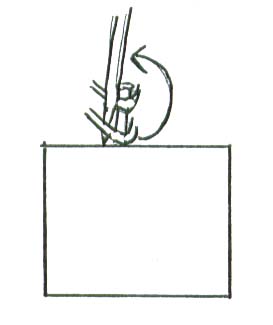

The knitting frame was invented by the Reverend William Lee in 1589. Though Queen Elizabeth I reportedly liked the silk stockings he knitted for her, she denied him a patent because she feared his machine would put hand knitters out of business. Lee's original machine had 8 needles to the inch and involved vertical sinkers moving upa nd down to make yarn loops and "bearded" needles retained the loops. He was able to knit a coarse fabric on his machine.
This is a smaller, simpler, hand loom version of Lee's machine but it will produce a more refined fabric using modern yarns.
Building a Knitting Board - Bolt together two 1X2 boards 24 inches long. The boards should be laying on their sides with the 1 inch sides facing up. Place a nut between the boards at each end to hold them apart. (The boards can be shorter or longer as you desire.)
Nail a row of 1 inch brad nails 1/4 of an inch away from the inside edge of both boards. Place the nails 1/4 inch apart. The row should extend the length of the board leaving about 2 inches at each end.
How to Knit on the Board
1. Casting on: Wind the yarn or thread around the nails as shown. You will be making "figure 8's".

2. Continue to wind from row 1, you wind row 2 by going back in the opposite direction. This time you do not have to mak ethe "figure 8" pattern, just wind around the nails as shown.

3. Using a yarn needle, upholstery needle or crochet hook, lift the bottom loop (row 1) over the top loop (row 2) and up over the top of the nail. Leaving only the second loop on the nail. Do this for each nail.
3a. Lay a piece of scrap yarn across the knitting allowing the ends to hang down between the boards.

4. Repeat steps 2 and 3. After a few rows are made, you will need to pull the fabric down out of the bottom of the boards. Use the string that you laid across the first completed row of stitches. This string will help you pull the fabric evenly.
5. Casting off: Starting at the end opposite where the yarn coming out of the skein is,m lift the loop off the first nail and place it over the nail and loop on the opposite side. Then, lift the top loop (the one that was already there) off and place it over the next nail and loop located diagonally across and lift the loop off. Each time you lieft the top loop off it should bring the lower loop with it. Continue working back and forth until you reach the last loop. Clip the yarn about 6 inches long and pull the 6 inch tail through the last loop and pull the loop snug. Your knitting may now be pulled out of the machine.
Bibliography
Grass, Milton and Anna. Stockings for a Queen: The Life of the Reverend William Lee, the Elizabethan Inventor. London: Heinmann, 1967.
Return to the Medieval Arts Page.
Unless otherwise noted, all text and drawings are copyright 2004 P. Girard
Email the page owner Lady Almaith